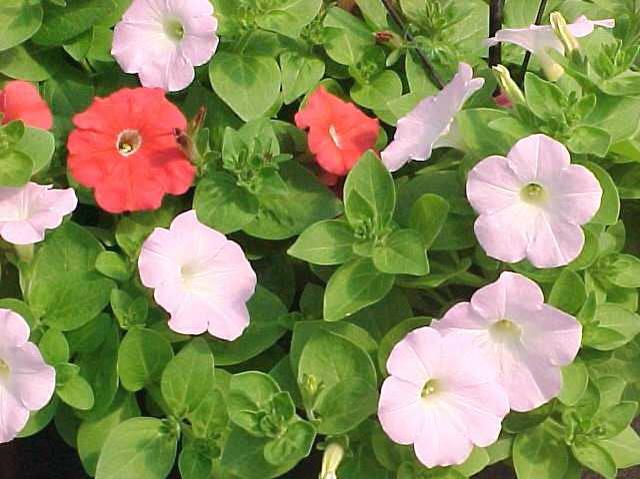Petunia (Petunia (group))
Petunia
Second only to impatiens in annual bedding plant sales, the petunia has been a popular plant for many years due in large part to its ease of culture and non-stop flowering from spring to frost. Most of the petunias commonly sold in commerce today are complex hybrids (P. axillaris x P. integrifolia). These hybrids are generally bushy to spreading in habit, typically growing 10-14” tall but spreading to as much as 2-3’ wide. They feature funnel-shaped single to double flowers in virtually all colors except brown and black with some picotees and bicolors. Common hybrid groupings include: Grandiflora hybrids (large flowers to 4” wide), Multiflora hybrids (smaller but more abundant flowers to 2” wide) and Cascading hybrids (pendulous-stemmed varieties useful in hanging baskets or as ground covers). Most flowers have some fragrance.
Genus name comes from the Latinized form of the Brazilian name petun for tobacco, to which these plants are closely related.

Tender perennial that is winter hardy to USDA Zones 10-1 In St. Louis, it is grown as an annual. Performs well in average, medium moisture, well-drained soils in full sun to light shade. Tolerates poor soils as long as drainage is good. Although many petunias may be grown from seed sown indoors 10-12 weeks before last frost date, many gardeners search local nurseries for interesting cultivars in inexpensive cell/six packs and only resort to seed in situations where a specific cultivar is sought that is only available from seed. Purchased plants often benefit from pinching at the time of planting. Prompt deadheading of spent flowers promotes more rapid formation of new buds. Cut back plants that become leggy. If plants decline in the heat of summer, cut back to stimulate later bloom. Favorite or unique plants may be overwintered indoors in bright cool location. Most hybrids do not come true from seed.
| Hardiness zone | 10 - 11 |
| Sun light | Full sun to part shade |
| Water | Medium |
| Maintenance | Low |
No serious insect or disease problems. Susceptible to root rot, gray mold, late blight and tobacco mosaic virus. Watch for aphids, flea beetles, slugs and snails.
Beds, borders, edging, or ground cover. Containers, window boxes, hanging baskets.
| Common name | Petunia |
| Botanical name | Petunia (group) |
| Plant type | Herbaceous perennial |
| Family | Solanaceae |
| Hardiness zone | 10 - 11 |
| Water | Medium |
| Maintenance | Low |
| Flower color | All colors except brown and black |
| Flowering period | May - frost |
| Height | 0.75 to 1 ft. |
| Width | 1 - 3 ft. |